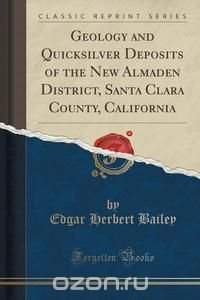Excerpt from Geology and Quicksilver Deposits of the New Almaden District, Santa Clara County, California
The New Almaden district, situated a few miles south of San Jose in Santa Clara County, Calif., has yielded nearly 40 percent of the quicksilver produced in the United States. The area mapped as the district for this report includes about 80 square miles, extending south from the flat Santa Clara Valley across the moderately low foothills containing the mines to the more rugged crest of the California Coast Ranges.
The rocks underlying about three-fourths of the district. Including all of the mineralized area, are assigned on the basis of lithology to the Franciscan group of Late Jurassic and Cretaceous age. The only diagnostic fossils found Indicate that the age of a part of the group Is lower Upper Cretaceous (Cenomanlan). The group consists of llthlc and feldspathic graywacke, slltstone, dark altered volcanic rocks, chert, limestone, and a subordinate amount of metamorphlc rocks, Including glaucophane schists - an assemblage regarded as a typical eugeosyncllnal suite. The thickness of the group cannot be determined accurately because of structural complexities, but the part present in the New Almaden district is believed to be at least 10,500 feet thick and may be much thicker. The sedimentary rocks are believed to have been derived from the rapid erosion of a rising landmass, and deposited In a subsiding trough which filled to wave base only in a few places near the end of the deposltlonal period. The accompanying Igneous activity Included local outpourings of lava onto the sea floor and eruption of fragmental material of similar composition which accumulated as pyroclastlc beds. The chert is abundant only In the part of the Franciscan group that contains altered volcanic rocks, and it Is believed to owe Its origin to the reaction of hot lava with sea water.
The post-Franciscan sedimentary rocks, which do not occupy large areas, range in age from Upper Cretaceous to Recent. Two sedimentary units, differing in both llthology and degree of deformation, have been assigned on the basis of a few fossils to the Upper Cretaceous. The next younger sedimentary rocks are dated as middle Eocene by fossils occurring In limestone lenses near the base of a sequence of sandstones and shales. Rocks of early, middle and late Miocene age containing abundant fossils are divided Into two formations, the rocks of which grade from sandstone through clay shale to dlatoma-ceous shale. The sandy sedimentary rocks below the lowest diatomaceous bed have been assigned to the Temblor formation, and this bed and the overlying rocks have been assigned to the Monterey shale. Some included salic volcanic material Indicates igneous activity during the middle Miocene. The younger sedimentary rocks in the district are all gravel deposits, which fill the larger valleys and occur as perched remnants on some of the lower foothills. They have been divided, largely on the basis of their dissection and topographic position, Into the Pliocene and Pleistocene Santa Clara formation and Quaternary alluvium.
Tabular masses of serpentine that have been Intruded into the rocks of the Franciscan group are of particular interest because altered parts of them contained the quicksilver ore bodies. Some of these masses are conformable with the rocks of the group and are therefore sills; others are intruded along faults that dip more steeply than the bedding. The larger masses consist of blocks of unsheared serpentine embedded in a matrix of sheared serpentine; the smaller masses and the borders of the larger ones consist entirely of sheared serpentine. The internal structures and details of the contacts, together with theoretical considerations, suggest that the serpentine masses were intruded as serpentine, not as peridotitic magma. The age of the serpentine cannot be closely placed by the evidence available in the district, but by comparison. Это и многое другое вы найдете в книге Geology and Quicksilver Deposits of the New Almaden District, Santa Clara County, California (Classic Reprint) (Edgar Herbert Bailey)
